Train Service in Rawdon

Much of the following content was taken from an article written by Dr. Glenn F Cartwright on the centennial of the arrival of the first train in Rawdon.
Writing in 1836, Farmer George Copping recounts that a journey, by horse, to the market in Montreal to sell about barrel of potash and some butter involved a first a day trip to l’Assumption, an overnight stay there, and another day’s travel following the l’Assumption River to its mouth at Charlemagne.There one could pay a boat man to cross to Bout de l’Isle on the Island of Montreal and travel another 25 km to the heart of the city. What was a two day trip in 1836, takes just over an hour by automobile today.
Remarkably, the Township of Rawdon was served by, and later abandoned by, at least two different railways in two different centuries before a station was actually in the village of Rawdon. The earliest station was at Montcalm Corners, now the Parish of St.Ligouri
The first railroad in British North America, John Molson’s Champlain and Saint Lawrence Railroad, was built in 1835.
The first rail line to Rawdon was the result of Jedidiah Hubble Dorwin’s, (a Montreal businessman with personal interests in Rawdon), research and promotion of a plan to extend the Lanoraie – Village de L’Industrie (Joliette) rail line 13 miles to Rawdon.
In 1847, legislation was enacted allowing a new railway, the Saint Lawrence and Industry Village Railroad to be extended downstream from Montreal on the Saint Lawrence River, northwest to Industry Village (today the city of Joliette.
Dorwin realised that if he could build a railway from Rawdon (currently on the line to Montcalm and 6 miles outside the village of Rawdon) to connect with the St. Lawrence and Industrial Railway as far as Lanoraie, he could have access to the St. Lawrence River where steamboats carried goods upstream to Montreal and downstream to Quebec City.
In 1850 notice of a subscription of stock to finance a railroad between Industry (Joliette) was signed by J. H. Dorwin, John Jeffries, Alexander Daly, Samuel Anderson.
1851 04 24 the following Directors were elected:
Charles Wilson, D Kinnear and Company, JH Dorwin, John Jeffries, Alex Daly, Samuel Anderson, J.N. Ostell, A. N. Morin, John Pratt, Fotheringham and Workman, Norbert Dumas, J.H. Joseph, J. Tiffin, John Elliott.
Figures were presented to indicate this rail line could be built at a very reasonable cost and pay good dividends.
Besides pasenger, there were mills in Rawdon to supply lumber, good fields to grow hay and grain, and dairy farms to be shipped to market. Butter and cheese manufactured in Rawdon were recognized for their superior quality.
A list offering figures related to the cost of building this 13 mile extension of the railroad from Industry to Rawdon was presented.
Costs
Outlay Engineering £37
Land and Engineering £30
Grubbing and Grading £125
Superstructure, Bridges, Laying of Rails £ 265
Iron and Spikes £272
Interest, Salaries, advertising, incidental expenses £22
=====================================
Total per mile £ 741 per mile
Buildings and fences £ 59 per mile
Equipment £200 per mile
Total Cost for the Railway £1,000 per mile
The Total Cost of the 10.5 Mile Extension £10,500
Compared with the cost in other parts of North America this amount of track would deliver only 2.5 miles, or in Great Britain 1 mile.
Although the maximum speed of the train was 22.5 km an hour it was subject to many stops for repairs prolonging the trip noticeably. People claimed that frequently there was to get out and pick berries during the stops along the route.
The railway was built with wooden rails faced with iron strips, and had a top speed of 14 mph.
This new railway, The industry Village and Rawdon Railway with Dorwin as its president, was opened on December 4, 1852, and The Montreal Gazette of December 8 proudly reported the festivities with much fanfare.
According to The Gazette, directors boarded the steamer Jaques Cartier at Montreal for the trip to Lanoraie and travelled up to Industry Village on the St. Lawrence and Industry Railroad.
Presumably using the same rolling stock, they continued on to Montcalm on the new railway.
During the train ride to the new station heavy rain obliged the canvas on the windows to be drawn obliviating the passing scenery.
An elaborate dinner alfresco had been prepared for the celebrants. The rain cancelled this plan and arrangements were made to dine at a local house. One might have reason to believe that the house belonged to Philemon Dugas who had a large place nearby.
The return train ride to Lanoraie was dull due to the canvas shutting out the view, otherwise without incident.
On the steamboat speeches and numerous toast given. Dorwin asserted that his new line was the cheapest railway in the world for it cost just £741 pounds per mile to construct, a feat then thought to guarantee future financial success. Still, additional investors were required and Darwin promised them 12% return on their money.
Among the additional investers, the St Sulpice Fathers invested £1000.
For unknown reasons, the Industry Village and Rawdon Railway lasted only a few years and by 1856 was bankrupt; on January 10, 1860 the assets were sold in the parish of Saint Ligouri, once a stop on the defunct railroad.
Once the preferred creditors, including the St. Sulpices, were satisfied the remaining assts were offered for auction.
None other than the ever flamboyant Dorwin, representing his friend Peter McGill, (the second mayor of Montreal 1840 to 1842) offered a bid on the remnants of the railway for a mere £450.
This bid was successful.
Une grande partie du contenu suivant a été tirée d’un article écrit par le Dr Glenn F Cartwright à l’occasion du centenaire de l’arrivée du premier train à Rawdon.
Selon le Dr Cartwright, le canton de Rawdon a été desservi, puis abandonné par au moins deux chemins de fer différents au cours de deux siècles différents avant qu’une gare ne soit installée dans le village de Rawdon. La première gare se trouvait à Montcalm Corners, aujourd’hui la paroisse de St-Ligouri.
En 1836, le fermier George Copping raconte que pour se rendre à cheval au marché de Montréal afin d’y vendre un baril de potasse et du beurre, il fallait d’abord se rendre à l’Assomption, y passer la nuit, puis suivre la rivière de l’Assomption jusqu’à son embouchure à Charlemagne, où l’on pouvait payer un batelier pour traverser jusqu’au Bout de l’Isle, sur l’île de Montréal, et parcourir 25 km de plus jusqu’au cœur de la ville. Ce qui représentait un voyage de deux jours en 1836 prend aujourd’hui un peu plus d’une heure en voiture.
Le premier chemin de fer en Amérique du Nord britannique, le Champlain and Saint Lawrence Railroad de John Molson, a été construit en 1835.
La première ligne de chemin de fer jusqu’à Rawdon est le résultat des recherches de Jedidiah Hubble Dorwin (un homme d’affaires montréalais ayant des intérêts personnels à Rawdon) et de la promotion d’un plan visant à prolonger la ligne de chemin de fer Lanoraie – Village de l’Industrie (Joliette) sur une distance de 13 milles jusqu’à Rawdon.
En 1847, une loi a été promulguée pour permettre le prolongement d’un nouveau chemin de fer, le Saint Lawrence and Industry Village Railroad, en aval de Montréal sur le fleuve Saint-Laurent, au nord-ouest d’Industry Village (aujourd’hui la ville de Joliette).
Dorwin s’est rendu compte que s’il pouvait construire une voie ferrée à partir de Rawdon (actuellement sur la ligne à Montcalm et à 6 miles à l’extérieur du village de Rawdon) pour se connecter au chemin de fer du Saint-Laurent et de l’Industrie jusqu’à Lanoraie, il pourrait avoir accès au fleuve Saint-Laurent où les bateaux à vapeur transportaient des marchandises en amont jusqu’à Montréal et en aval jusqu’à la ville de Québec.
En 1850, un avis de souscription d’actions pour financer un chemin de fer entre Industry (Joliette) est signé par J. H. Dorwin, John Jeffries, Alexander Daly et Samuel Anderson.
1851 Le 24 avril, les directeurs suivants sont élus :
Charles Wilson, D Kinnear and Company, JH Dorwin, John Jeffries, Alex Daly, Samuel Anderson, J.N. Ostell, A. N. Morin, John Pratt, Fotheringham and Workman, Norbert Dumas, J.H. Joseph, J. Tiffin, John Elliott.
Les chiffres présentés indiquent que cette ligne de chemin de fer pourrait être construite à un coût très raisonnable et rapporter de bons dividendes.
Outre le transport de passagers, il y avait à Rawdon des scieries pour fournir du bois, de bons champs pour cultiver le foin et les céréales, et des fermes laitières à expédier sur le marché. Le beurre et le fromage fabriqués à Rawdon sont reconnus pour leur qualité supérieure.
Une liste de chiffres relatifs au coût de la construction de cette extension de 13 miles de la voie ferrée d’Industry à Rawdon a été présentée.
Côuts
Dépenses Ingénierie £37
Terrain et ingénierie £30
Arrachage et nivellement £125
Superstructure, ponts, pose de rails £ 265
Fer et pointes £272
Intérêts, salaires, publicité, frais accessoires £22
======================================
Total par mile £ 741 par mile
Bâtiments et clôtures £ 59 par mile
Équipement 200 £ par mile
Coût total pour le chemin de fer 1 000 £ par mile
Coût total de l’extension de 10,5 miles £10,500
Par rapport au coût des autres régions d’Amérique du Nord, cette longueur de voie ne permet de parcourir que 2,5 miles, ou 1 mile en Grande-Bretagne.
Bien que la vitesse maximale du train soit de 22,5 mile à l’heure, il devait s’arrêter à de nombreuses reprises pour effectuer des réparations, ce qui prolongeait considérablement le voyage. Les gens affirmaient qu’il était fréquent de sortir et de cueillir des baies lors des arrêts le long de la route.
Le chemin de fer était construit avec des rails en bois recouverts de bandes de fer, et sa vitesse maximale était de 14 mph.
Ce nouveau chemin de fer, The Industry Village and Rawdon Railway, dont Dorwin est le président, est inauguré le 4 décembre 1852, et The Montreal Gazette du 8 décembre rapporte fièrement les festivités avec beaucoup de fanfare.
Selon The Gazette, les directeurs montent à bord du vapeur Jaques Cartier à Montréal pour se rendre à Lanoraie et voyagent jusqu’à Industry Village sur le chemin de fer du Saint-Laurent et de l’Industrie.
Utilisant vraisemblablement le même matériel roulant, ils poursuivent leur route jusqu’à Montcalm sur le nouveau chemin de fer.
Pendant le trajet jusqu’à la nouvelle gare, une forte pluie oblige à tirer la toile des fenêtres, ce qui empêche de voir le paysage qui défile.
Un dîner élaboré en plein air avait été préparé pour les célébrants. La pluie a annulé ce plan et des dispositions ont été prises pour dîner dans une maison locale. On peut penser que cette maison appartenait à Philemon Dugas, qui possédait une grande propriété dans les environs.
Le voyage de retour en train jusqu’à Lanoraie fut ennuyeux en raison de la toile qui fermait la vue, mais il se déroula sans incident.
Sur le bateau à vapeur, des discours et de nombreux toasts sont prononcés. Dorwin affirme que sa nouvelle ligne est le chemin de fer le moins cher du monde car sa construction ne coûte que 741 livres sterling par mile, un exploit que l’on croyait alors garant d’un futur succès financier. Cependant, des investisseurs supplémentaires sont nécessaires et Darwin leur promet un rendement de 12 % sur leur argent.
Parmi les investisseurs supplémentaires, les Pères de St Sulpice ont investi 1000 livres.
Pour des raisons inconnues, l’Industry Village and Rawdon Railway ne dura que quelques années et fit faillite en 1856 ; le 10 janvier 1860, les actifs furent vendus dans la paroisse de Saint Ligouri, qui était autrefois un arrêt de la défunte ligne de chemin de fer.
Une fois que les créanciers privilégiés, y compris les St-Sulpices, ont été satisfaits, les biens restants sont mis aux enchères.
Nul autre que le toujours flamboyant Dorwin, représentant son ami Peter McGill (deuxième maire de Montréal de 1840 à 1842), fait une offre sur les vestiges du chemin de fer pour la modique somme de 450 livres sterling.
Cette offre est acceptée.
Traduit avec DeepL.com (version gratuite)
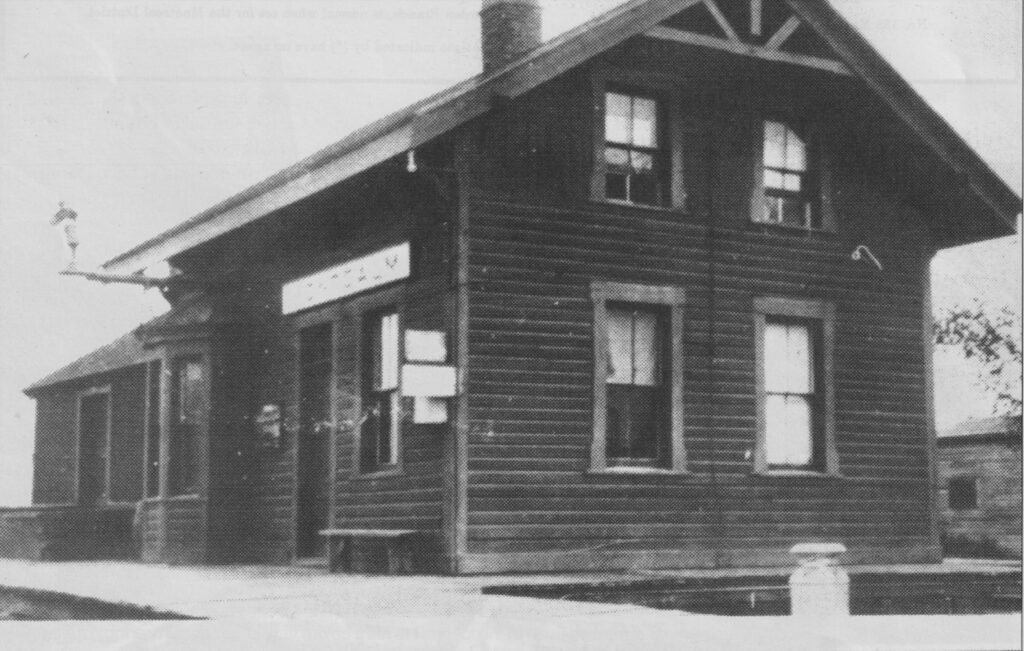
The Montcalm Station
The Great Northern Railway of Canada lasted only 14 years and was soon incorporated into the Canadian Northern Quebec Railway Co. (1906 to 1919). Meanwhile, under the terms of its charter, the Chateauguay and Northern Railroad Company (1895 to 1906) completed construction from Rawdon Junction on the Great Northern 4 miles south to Saint Jacques on November 3, 1909.
Rawdonites could board a Great Northern of Canada train at Montcalm in the early morning hours and, presumably, change trains at Saint Jérôme for Montreal. A day trip to Montreal was now possible. The year was 1895.
The new Great Northern Line from Quebec City passed through Joliette, Montcalm, what was later to become Rawdon Junction, Saint Julienne, Saint Lin des Laurentides, New Glasgow, Montfort Junction, and onto Saint Jerome and beyond.
In addition to passengers, the railway transported grain, dairy products like butter and cheese, as well as lumber. Since Dorwin owned a mill in Rawdon, it is likely that logs were floated down the Oureau River to his mill, processed, and the lumber products shipped on his railway from Montcalm via Industry Village to the Saint Lawrence River. From there they could make their way to Montreal or even beyond by canal boat on the Richelieu River via Chambly to Whitehall and on to Albany and New York City freight shed. (Gazette 1852)
Though the exact route of Dorwin’s railway has never been fully traced, bridge abutments were said to be still visible. (Lavallée 1990). Since the annual report (1852- 53) indicating the line leased rolling stock and locomotives from the Saint Lawrence and Industry Village Railroad, the track structures must have been of similar construction and the gauge compatible. Might it be the Dorchester ever have travelled to Rawdon?
Since the Champlain and St. Lawrence and Industry Railroad later became part of the Canadian Pacific Railway, Canada’s first locomotive, the Dorchester ran on both of what were eventually to become Canada’s two major railways.
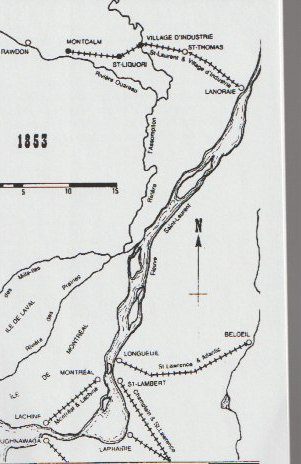

Rawdonites could board a Great Northern of Canada train at Montcalm in the early morning hours and, presumably, change trains at Saint Jérôme for Montreal. A day trip to Montreal was now possible. The year was 1895.
Rawdonites could board a Great Northern of Canada train at Montcalm in the early morning hours and, presumably, change trains at Saint Jérôme for Montreal. A day trip to Montreal was now possible. The year was 1895.
The new Great Northern Line from Quebec City passed through Joliette, Montcalm, what was later to become Rawdon Junction, Saint Julienne, Saint Lin des Laurentides, New Glasgow, Montfort Junction, and onto Saint Jerome and beyond.
Some 44 years passed without a railway service to Rawdon until the Great Northern Railway of Canada began constructing a line from Quebec City to Parry Sound, Ontario. At Perry Sound, a connection could be made by steamer to Duluth, Minnesota and onward on the Great Northern Railway in the United States (built by Canadian James Hill) was possible. The new line shortened the distance between Duluth and Liverpool, England, by some 800 miles over the conventional route through Buffalo and New York City. The Great Northern of Canada passed to the north of Montreal avoiding the metropolis in favour of Quebec City as the port of Montreal was closed in winter. Quebec, although occasionally clogged with ice, it was considered a year – round port.
Quelque 44 années s’écoulent sans service ferroviaire à Rawdon, jusqu’à ce que le Chemin de fer du Grand Nord du Canada entreprenne la construction d’une ligne entre la ville de Québec et Parry Sound, dans l’Ontario. À Perry Sound, une liaison peut être établie par bateau à vapeur jusqu’à Duluth, au Minnesota, et il est alors possible de poursuivre sur le Great Northern Railway aux États-Unis (construit par le Canadien James Hill). La nouvelle ligne raccourcit la distance entre Duluth et Liverpool, en Angleterre, de quelque 800 miles par rapport à l’itinéraire classique passant par Buffalo et New York City. Le Great Northern of Canada passe au nord de Montréal, évitant la métropole au profit de la ville de Québec, le port de Montréal étant fermé en hiver. Le port de Québec, bien qu’il soit parfois encombré par les glaces, est considéré comme un port ouvert toute l’année.
Though the exact route of Dorwin’s railway has never been fully traced, bridge abutments were said to be still visible. (Lavallée 1990). Since the annual report (1852- 53) indicating the line leased rolling stock and locomotives from the Saint Lawrence and Industry Village Railroad, the track structures must have been of similar construction and the gauge compatible. Might it be the Dorchester ever have travelled to Rawdon?
La ligne ferroviaire vers Rawdon
For passengers wanting to get to Montreal the Great Northern Railway Station at Montcalm Corners took them to St Jerome where they transferred to a C.P.R train going to Place Viger in Montreal.
Later a train between Joliette and Montreal let travellers off at Lasalle Street in Montreal.
There was no C.N.R. Station in Montreal until CNR bought a block of tenements at Moreau and St. Catherine Street.
Later a train between Joliette and Montreal let travellers off at Lasalle Street in Montreal. There was no station until CNR bought a block of tenements at Moreau and St Catherine Streets to make a station.
In 1900 there was also an option to travel to l’Epiphanie by train then take a coach to Rawdon.
Pour les passagers qui voulaient se rendre à Montréal, la gare de la Great Northern Railway à Montcalm Corners les emmenait à Saint-Jérôme, où ils étaient transférés dans un train du C.P.R. qui se rendait à la Place Viger à Montréal.
Plus tard, un train reliant Joliette à Montréal laissait descendre les voyageurs à la rue Lasalle, à Montréal.
Il n’y avait pas de gare jusqu’à ce que le CNR achète un bloc de tènements à l’angle des rues Moreau et Sainte-Catherine pour y aménager une gare.
Plus tard, un train entre Joliette et Montréal laissait descendre les voyageurs à la rue Lasalle à Montréal. Il n’y avait pas de gare jusqu’à ce que le CN achète un bloc de tènements à l’angle des rues Moreau et Sainte-Catherine pour en faire une gare.
En 1900, il était également possible de se rendre à l’Épiphanie en train, puis de prendre un coach jusqu’à Rawdon.
Train to Rawdon Village 1910-1961 Train jusqu’à Rawdon Village
The population of Rawdon in 1910 was 1,200. En 1910, Rawdon comptait 1 200 habitants.
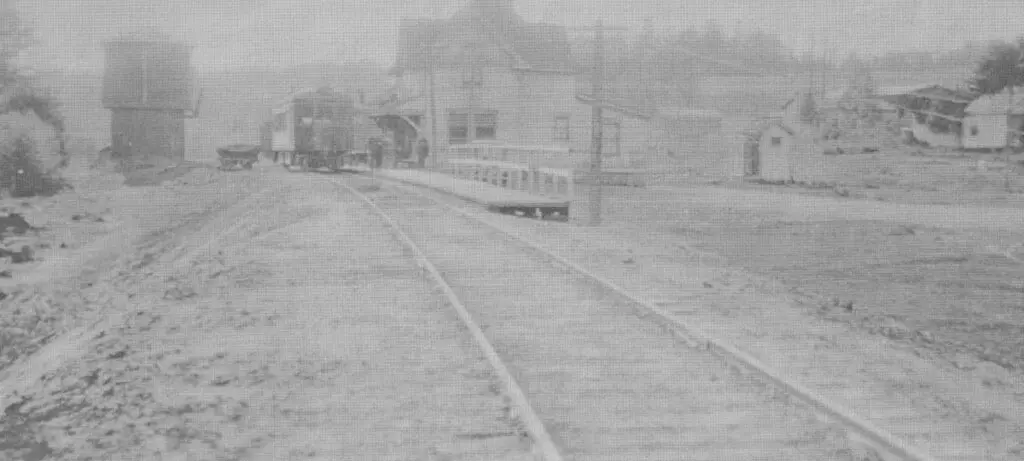
Notez le réservoir d’eau à l’extrême gauche et l’hôtel de Ma Tante à droite.
Under the terms of its charter, the Chateauguay and Northern Railroad Company (1895 to 1906) completed construction from Rawdon Junction on the Great Northern 4 miles south to Saint Jacques on November 3, 1909.
En vertu de sa charte, la Chateauguay and Northern Railroad Company (1895 à 1906) a achevé la construction du chemin de fer de Rawdon Junction sur le Great Northern à 4 milles au sud de Saint-Jacques le 3 novembre 1909.
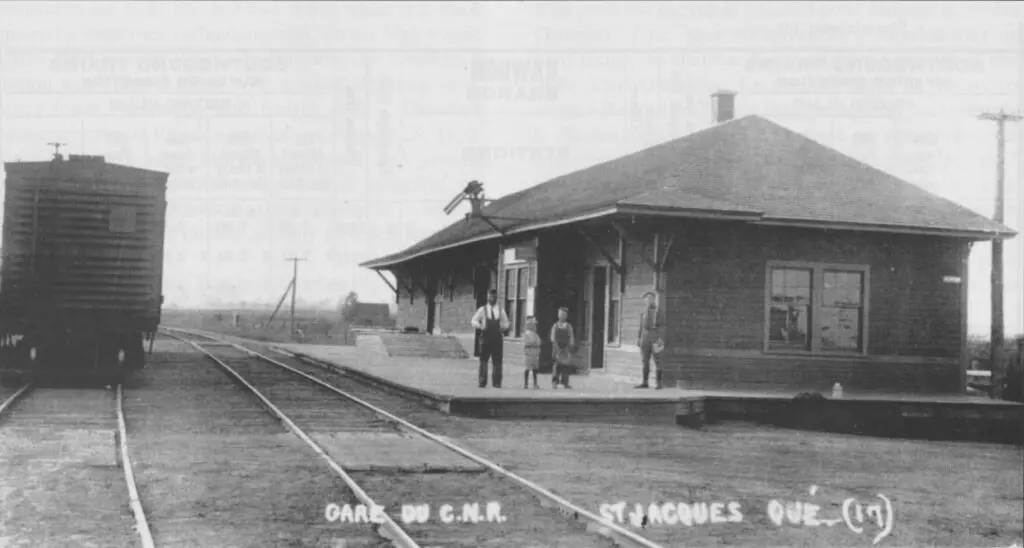
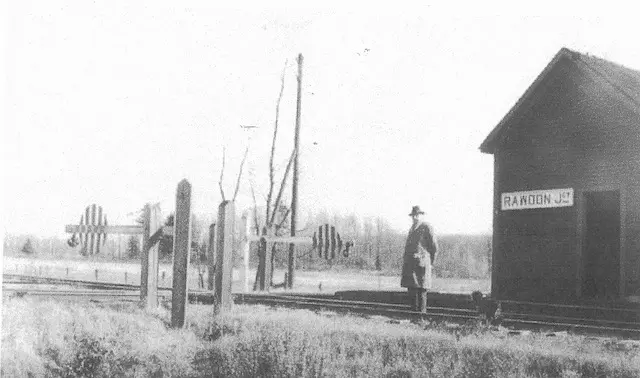
Less than a year later, the rails had stretched to Rawdon Junction a distance of 4.7 miles (approximatelty 7 k ). This new line was unspectacular until the last 2 miles when the track entered a large trestle built to cross the Oureau River merging onto a high trestle across the Oureau River into Rawdon.
Moins d’un an plus tard, les rails s’étendaient jusqu’à Rawdon Junction, sur une distance de 4,7 miles (environ 7 km). Cette nouvelle ligne n’était pas spectaculaire jusqu’aux deux derniers miles, lorsque la voie s’engagea dans une grande tranchée rocheuse et déboucha sur un haut chevalet traversant la rivière Oureau jusqu’à Rawdon.
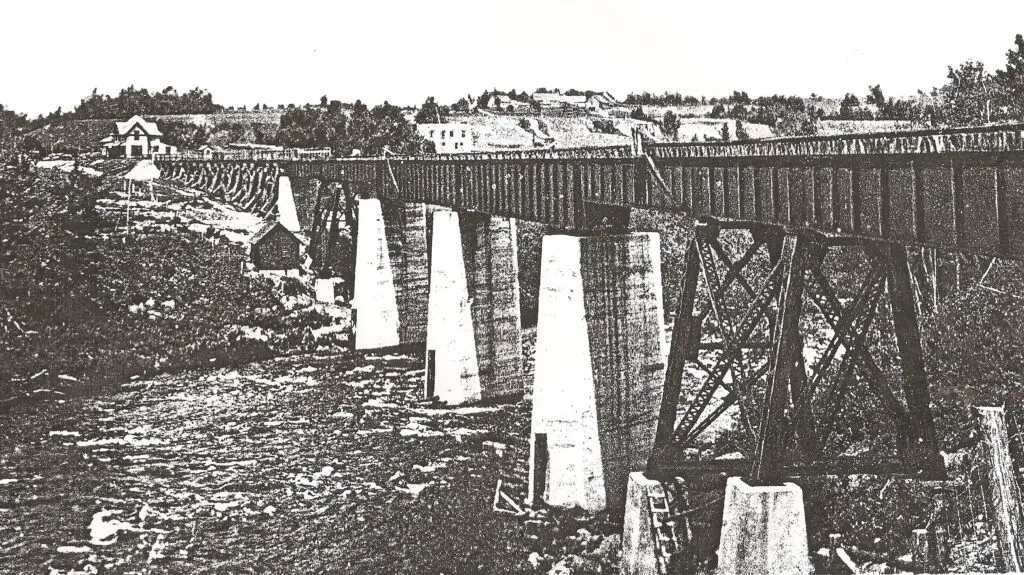
The station is visible in the background on the left and Henry Hanna’s farm on the right. Looking closely on the right centre the top of Ma Tante’s Hotel. (later the Manchester Hotel, or “below the hill” in local parlance.
Here travellers could wait for the train and enjoy “refreshment” instead of in the waiting room in the station house.
La gare est visible à l’arrière-plan à gauche et la ferme d’Henry Hanna à droite. En regardant de près, au centre à droite, on aperçoit le sommet de l’hôtel Ma Tante. (plus tard l’hôtel Manchester, ou « en bas de la colline » dans le jargon local.
Les voyageurs pouvaient y attendre le train et profiter d’un « rafraîchissement » au lieu d’attendre dans la salle d’attente de la gare.
The train crossed the Oureau River on a large trestle to the flats at the bottom of the hill on Metcalfe Street which, at the time, was considered out of the village.
The youth in 1910, just as today, were adventurous and despite warnings would cross the trestle on foot. There was at least one close call involving an approaching train.
The first passenger trip to Rawdon arrived on August 28, 1910, some 54 years after Dorwins first railroad had ceased operations. Construction was deemed complete on September 7, 1910. Rawdon’s third railway, second century, but the first railway actually to reach Rawdon.
Construction was completed on September 7, 1910. Rawdon’s third railway, second century, but the first railway to reach the Village of Rawdon.
Le train traversait la rivière Oureau sur un grand chevalet jusqu’à la plaine située au bas de la colline, dans la rue Metcalfe qui, à l’époque, était considérée comme hors du village.
Les jeunes de 1910, tout comme ceux d’aujourd’hui, étaient aventureux et, malgré les avertissements, traversaient le pont à pied. Il y a eu au moins une fois un accident évité de justesse en raison de l’approche d’un train.
Le premier voyage de passagers vers Rawdon eut lieu le 28 août 1910, quelque 54 ans après l’arrêt des activités de la première ligne de chemin de fer de Dorwin. La construction est achevée le 7 septembre 1910. Troisième chemin de fer de Rawdon, deuxième siècle, mais premier chemin de fer à atteindre Rawdon.
La construction est terminée le 7 septembre 1910. Troisième chemin de fer de Rawdon, deuxième siècle, mais premier chemin de fer à atteindre le village de Rawdon.
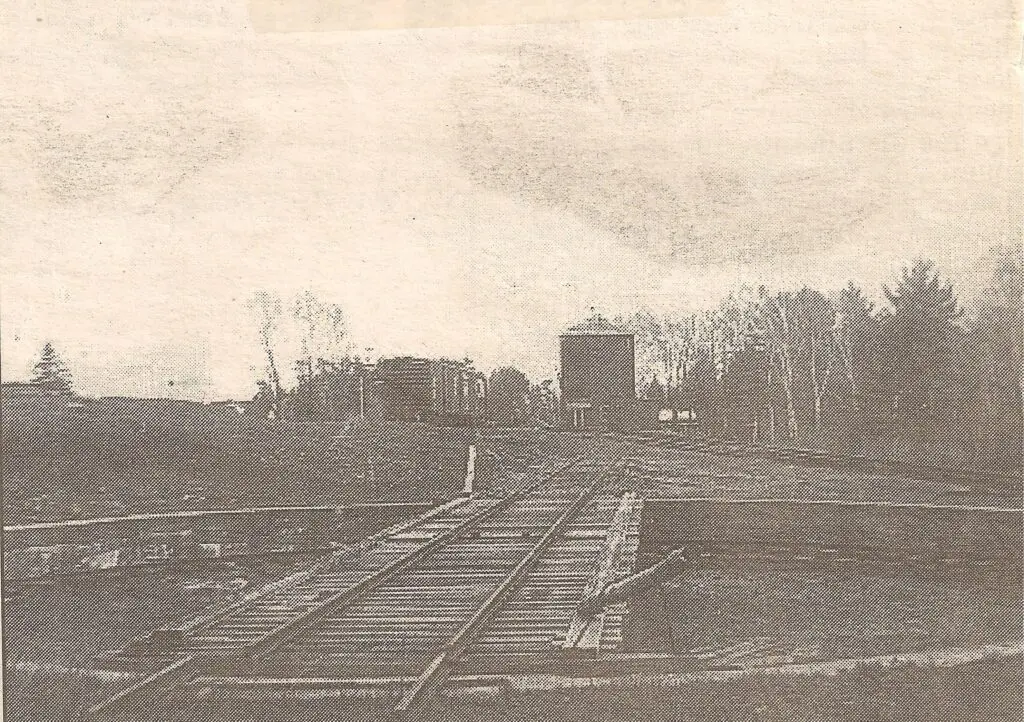
Le rond-point au premier plan, le château d’eau à l’arrière
Rawdon, being the end of the line required a water tower to refill the steamengine as well as a turn table to turn the engine around for the return trip.
The engine was driven onto the platform which was then turned manually heading the engine back to Montreal.
This view of the trestle crossing the Oureau River shows the Hannah farm in the background. The white building to the right of the station is Ma Tante’s Hotel.
With only two hands, an engineer and a conductor on the train, helping hands were needed to turn the round-a-bout.
This was never a difficulty as many young, and not so young, lads took great pride in helping turn the engine. There were always helping hands waiting on the arrival of the train.
The detail of the volunteers turning of the train was shared by Donald Tinkler who confessed to be one of the regulars waiting at the station to help turn the engine around.
Thank you, Donald.
Rawdon, qui se trouve à la fin de la ligne, a besoin d’un château d’eau pour remplir la machine à vapeur, ainsi que d’une table tournante pour faire tourner la machine pour le voyage de retour.
La locomotive était conduite sur la plate-forme qui était ensuite tournée manuellement en direction de Montréal.
Cette vue du pont à chevalets traversant la rivière Oureau montre la ferme Hannah à l’arrière-plan. Le bâtiment blanc à droite de la gare est l’hôtel Ma Tante.
Comme il n’y avait que deux personnes, un ingénieur et un conducteur sur le train, il fallait de l’aide pour tourner le rond-point.
Cela n’a jamais été un problème, car de nombreux jeunes, et moins jeunes, étaient très fiers d’aider à faire tourner la locomotive. Il y avait toujours des volontaires qui attendaient l’arrivée du train.
Donald Tinkler, qui a avoué être l’un des habitués qui attendaient à la gare pour aider à faire tourner la locomotive, a raconté en détail comment les bénévoles faisaient tourner le train.
Merci, Donald.
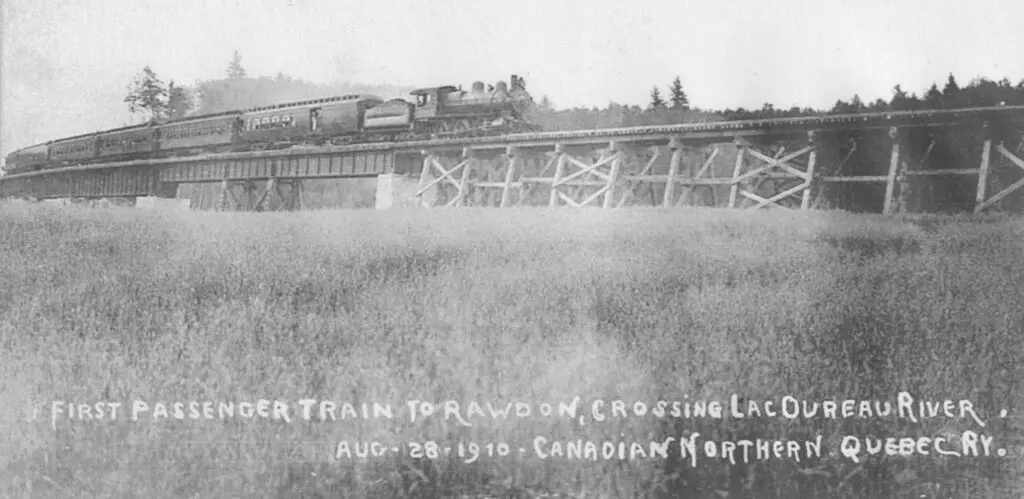
The first passenger trip to Rawdon arrived on August 28, 1910 some 54 years after the first rail service to Rawdon had ceased.
Construction was deemed complete on September 7, 1910.
The Chateauguay and Northern was merged into the Canadian Northern Quebec Railway which was absorbed into the Canadian National Railway’s in 1919.
Le premier voyage de passagers à Rawdon a eu lieu le 28 août 1910, quelque 54 ans après que le premier chemin de fer de Dorwin ait cessé ses activités.
La construction est achevée le 7 septembre 1910.
La Chateauguay and Northern a été fusionnée avec la Canadian Northern Quebec Railway, qui a été absorbée par la Compagnie des chemins de fer nationaux du Canada en 1919.
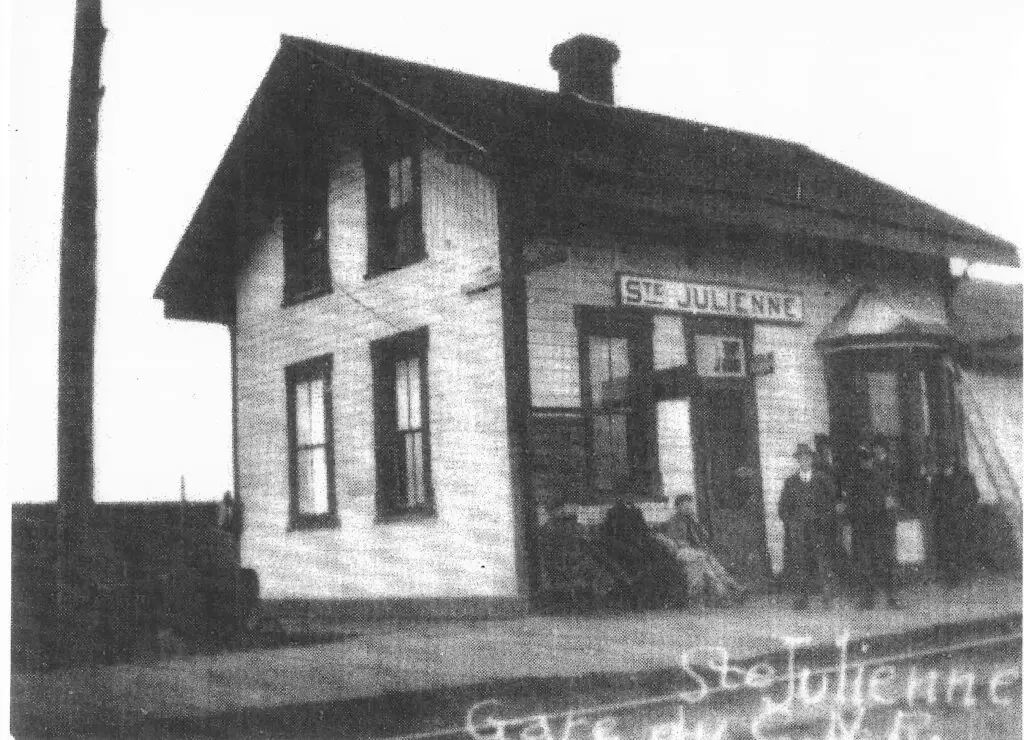
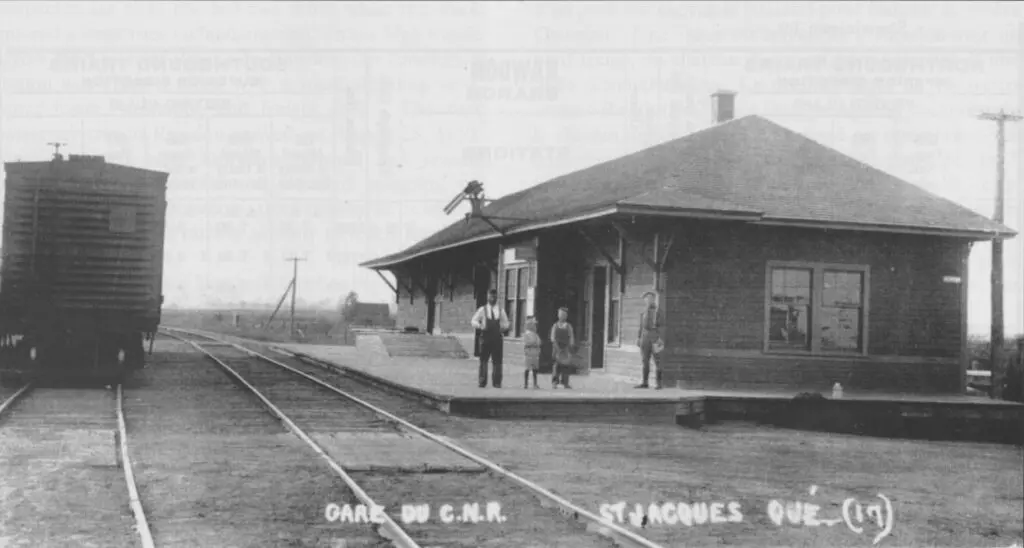
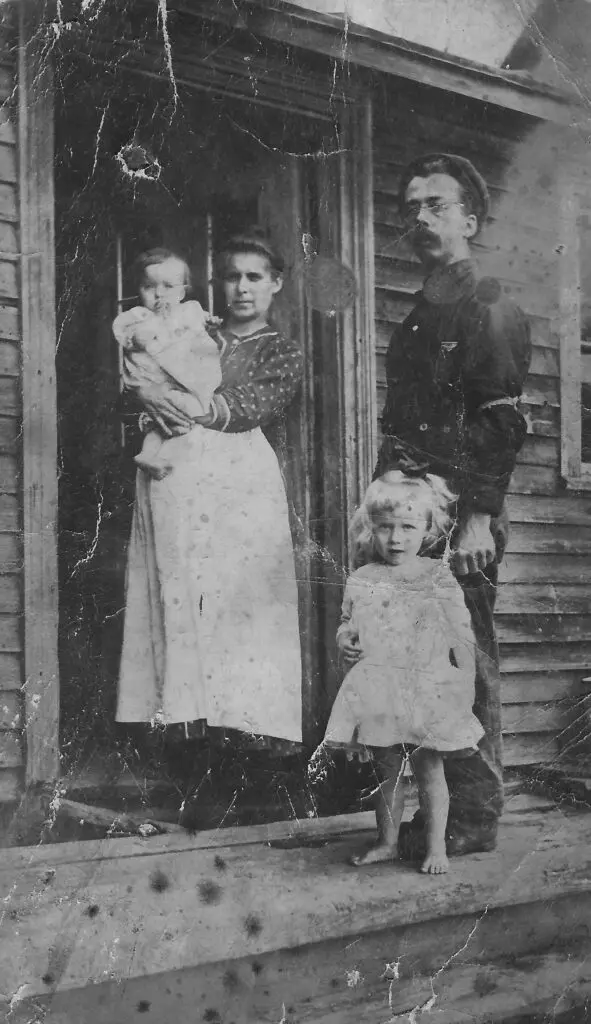
An early, if not the first, train master and his family who lived in the station. Records do not list the name of the station masters.
Blueprints dated 1909 indicate the line was originally going to St. Donat. The blueprints mark the alignment that had been planned. Apparently the project was abandonned.
For the station master’s family this was a lonely existance far away from the village centre. The steep hill leading into the village was challenging for his wife with a very young family.
Today another family resides in this building which has been altered beyond historic value.
Un des premiers, si ce n’est le premier, chef de gare et sa famille qui ont vécu dans la gare. Les archives ne mentionnent pas le nom des chefs de gare.
Des plans datant de 1909 indiquent que la ligne allait à l’origine jusqu’à Saint-Donat. Les plans indiquent le tracé qui avait été prévu. Apparemment, le projet a été abandonné.
Pour la famille du chef de gare, il s’agissait d’une existence solitaire, loin du centre du village. La colline escarpée menant au village était un défi pour sa femme qui avait une très jeune famille.
Aujourd’hui, une autre famille réside dans ce bâtiment qui a été modifié au point de ne plus avoir de valeur historique.

Remarquez l’enseigne télégraphique du CNR dans le coin gauche de la gare. Il est intéressant de noter l’architecture de ce bâtiment par rapport aux autres gares, beaucoup plus simples.
Not only was there a train to Rawdon but a telegraph office, as well. Consider the importance of this convenience for the citizens!
Il y avait non seulement un train pour Rawdon, mais aussi un bureau de télégraphe. Pensez à l’importance de cette commodité pour les citoyens.
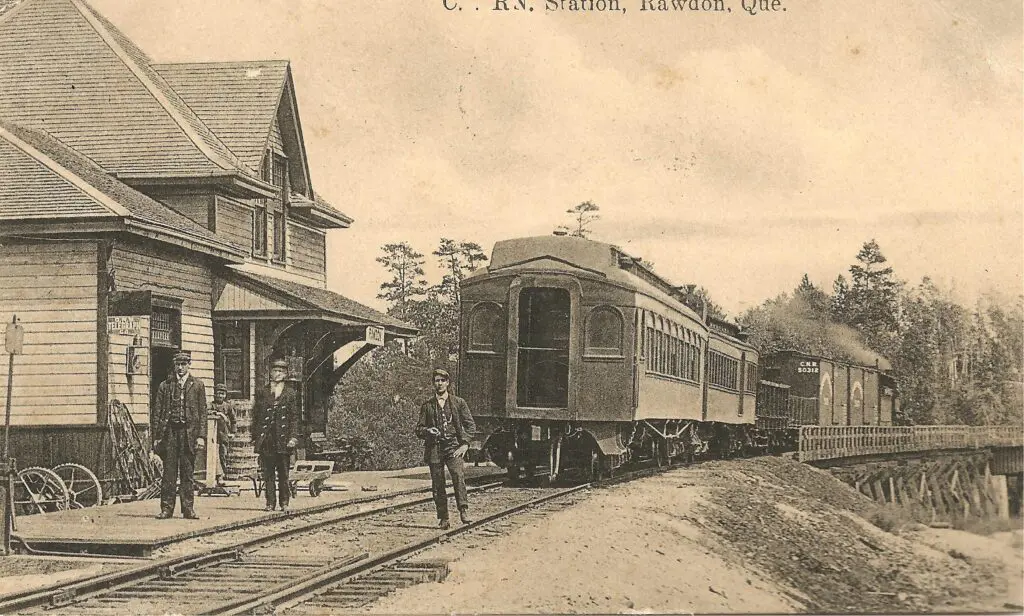
Le chef de gare, l’ingénieur et le conducteur
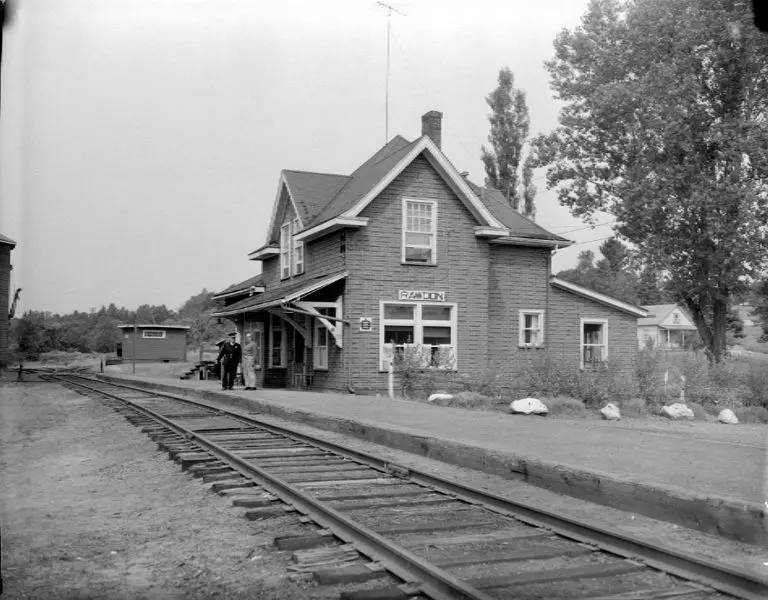
Les vêtements de l’homme suggèrent que cette photo a été prise vers la fin de la desservance de Rawdon par le train.
Canadian National trains from Rawdon would travel on the Rawdon subdivision southbound past flag stop Hamilton, Cordon, Saint Alexis, Saint Jacques, Rawdon Junction (crossing the former Great Northern), Saint Georges, and L’Epiphanie to join the l’Assomption Subdivision (line originally built from Joliette to Montreal by the Chateauguay and Northern Railroad) at Paradis.
Les trains du Canadien National en provenance de Rawdon empruntaient la subdivision Rawdon en direction du sud et passaient par les arrêts Hamilton, Cordon, Saint Alexis, Saint Jacques, Rawdon Junction (traversant l’ancien Great Northern), Saint Georges et L’Epiphanie pour rejoindre la subdivision l’Assomption (ligne construite à l’origine de Joliette à Montréal par la Chateauguay and Northern Railroad) à Paradis.
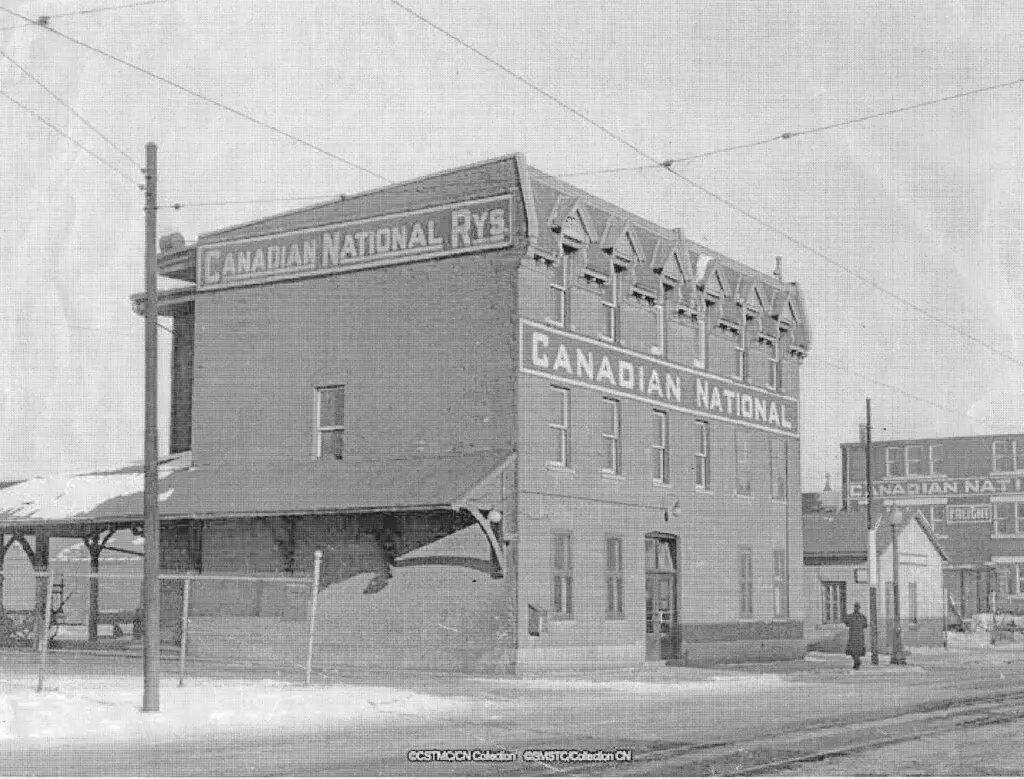
La gare Moreau, située à l’angle des rues Moreau et Sainte-Catherine Est, était le terminus du train de Rawdon.
The train then stopped at L’Assomption, St Paul l’Ermite , Charlemagne, and Cherrier, Pointe -aux – Trembles and onto the Long Point Subdivision to Maisonneuve, and into Moreau Street station on St. Catherine St. East. (New Rail Connection 1902).
Normally there were two trains to Rawdon. To accommodate the increased traffic during summers in the 1920s and 30s, passenger a third train was added to the schedule.
Prior to 1949, Sunday evening trains took a longer route, meandering from Rawdon via Rawdon Junction to Montcalm, Dugas, and Joliette where there was a 15 minute stop.
Montréal’s Central Station had opened in 1943 and by 1949 the CNR trains along the original Great Northern route (Joliette) to Saint Jerome were discontinued.
Le train s’arrête ensuite à L’Assomption, St Paul l’Ermite, Charlemagne et Cherrier, Pointeaux – Trembles, puis dans la subdivision Long Point jusqu’à Maisonneuve, et dans la gare de la rue Moreau sur la rue Sainte-Catherine Est. (Nouvelle liaison ferroviaire en 1902).
À son apogée, dans les années 1920 et 1930, le service voyageurs était assuré par deux trains par jour dans chaque sens, un troisième étant ajouté pendant l’été.
Avant 1949, les trains du dimanche soir empruntaient un itinéraire plus long, serpentant de Rawdon à Montcalm, Dugas et Joliette, en passant par Rawdon Junction, où il y avait un arrêt de 15 minutes.
La gare centrale de Montréal avait ouvert ses portes en 1943 et, en 1949, les trains du CN qui empruntaient le parcours original du Great Northern (Joliette) jusqu’à Saint-Jérôme avaient été supprimés.
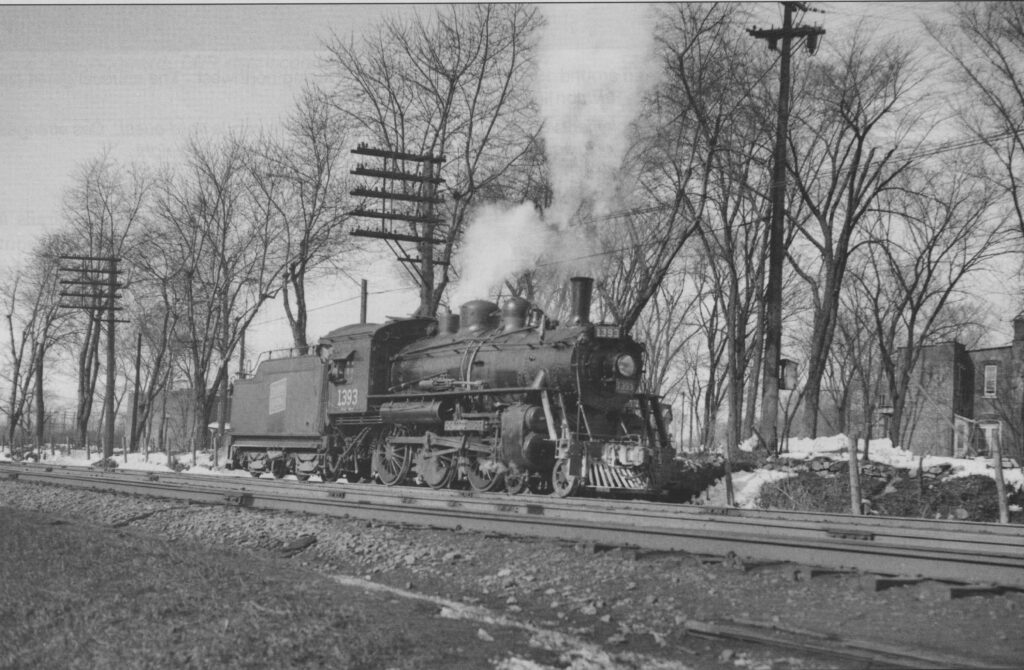
All trains from Rawdon were then routed through Rawdon Junction (no longer calling at Joliette) to Pointe – aux – Trembles and from there along the new belt – line to Montreal North, Pie IX, and Ahuntsic before arriving at Gohier for the change of locomotives from steam to electric for the short trip through the Mount Royal tunnel to Central Station.
Tous les trains en provenance de Rawdon sont alors acheminés par Rawdon Junction (qui ne fait plus escale à Joliette) jusqu’à Pointe-aux-Trembles et, de là, le long de la nouvelle ligne de ceinture jusqu’à Montréal-Nord, Pie IX et Ahuntsic avant d’arriver à Gohier pour le changement des locomotives de la vapeur à l’électricité pour le court trajet à travers le tunnel du Mont-Royal jusqu’à la gare centrale.
1924 An Electric Car in Rawdon Une voiture électrique à Rawdon
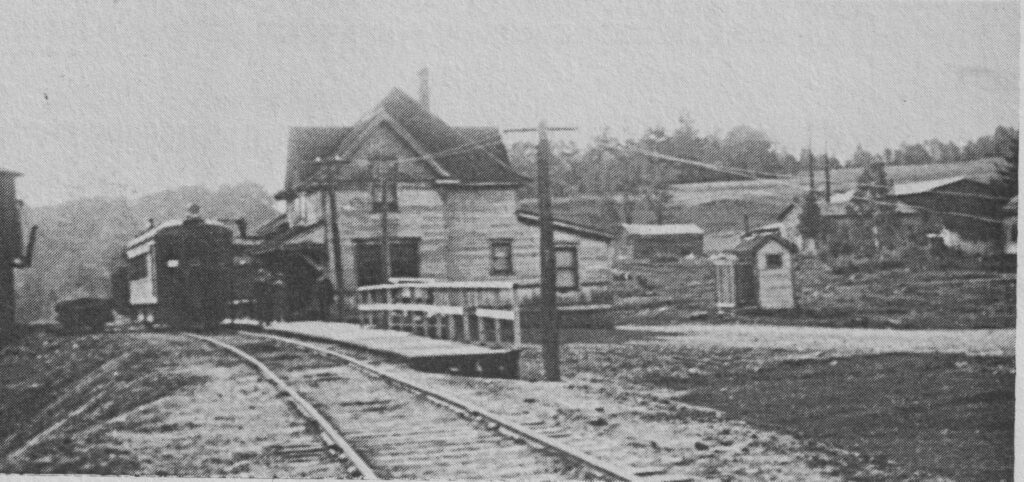
This very poor quality photo of the electric train at Rawdon Station, taken between April and September 1924, shows the electric train at the Rawdon Station.
Why were electric cars of interest? Compared with the capital cost of diesel cars, the battery cars cost slightly less.
The battery car, built in Montreal, weighed 30 tons, was 53′ 2″ long, weighed 73,800 pounds and seated 50 passengers.
Although the car was battery powered, it was heated with coal.
The car was equipped for double- ended operation thus there was no need for turning the car on the turntable.
Battery power had its limitations: one was the restriction of range, another the problem of operating through heavy snow, and another the 7 to 8 hours to recharge the batteries fully though it was possible the charge could be spread over two or three shorter charges in a 24-hour period.
It is not known if the car’s storage batteries were recharged in Rawdon but this was probably unlikely.
This single car made two round trips a day, leaving Montreal at 7 am for the first trip, the second trip from Rawdon returned to the Moreau Station at 5 pm.
The triain left Rawdon on the Rawdon Line, Hamilton, Cordon, St. Alexis, St. Jacques, Rawdon Junction and St. Georges.
These stops were not scheduled but on demand only. The Hamilton stop was used to connect cars to add a car, or cars, of sand or drop empty car(s) to be refilled.
Other stops collected cans of milk in the morning. The empties were dropped on the return trip.
To accommodate the increasing number of day and weekend tourists, during the period between June 15th and September 7th, on Sundays the train supplemented the regular twice daily trips adding a third trip using a steam engine.
The car was equipped for double-sided operation, eliminating the need to turn the car on the Armstrong turntable at Rawdon.
Rawdon’s electric car was replaced by a gasoline motor car which made two daily trips except on Sunday when only one trip was made. It was retired on July 14, 1925.
Cette photo de très mauvaise qualité du train électrique à la gare de Rawdon, prise entre avril et septembre 1924, montre le train électrique à la gare de Rawdon.
Pourquoi les voitures électriques étaient-elles intéressantes ? Par rapport au coût d’investissement des voitures diesel, les voitures à batterie coûtent un peu moins cher.
La voiture à batterie, construite à Montréal, pesait 30 tonnes, mesurait 53 pieds 2 pouces, pesait 73 800 livres et pouvait accueillir 50 passagers.
Bien que la voiture soit alimentée par des batteries, elle est chauffée au charbon.
Le wagon était équipé pour fonctionner à deux bouts, de sorte qu’il n’était pas nécessaire de le faire tourner sur la plaque tournante.
L’alimentation par batterie avait ses limites: l’une était la restriction de l’autonomie, une autre le problème de la conduite dans la neige épaisse, et une autre encore les 7 à 8 heures nécessaires pour recharger complètement les batteries, même s’il était possible d’étaler la charge sur deux ou trois charges plus courtes par période de 24 heures.
On ne sait pas si les batteries de stockage de la voiture ont été rechargées à Rawdon, mais c’est probablement peu probable.
Ce wagon unique effectuait deux allers-retours par jour, quittant Montréal à 7 heures du matin pour le premier voyage, le second voyage depuis Rawdon revenant à la gare de Moreau à 17 heures.
Le triain partait de Rawdon sur la Rawdon Line, Hamilton, Cordon, St-Alexis, St-Jacques, Rawdon Junction et St-Georges.
Les arrêts n’étaient pas prévus à l’horaire mais à la demande seulement. L’arrêt de Hamilton servait à relier des wagons pour ajouter un ou des wagons de sable ou déposer un ou des wagons vides à remplir.
D’autres arrêts collectaient des bidons de lait le matin. Les vides étaient déposées sur le chemin du retour.
Pour répondre au nombre croissant de touristes d’un jour ou d’un week-end, entre le 15 juin et le 7 septembre, le dimanche, le train complétait les voyages réguliers biquotidiens en ajoutant un troisième voyage à l’aide d’une locomotive à vapeur.
La voiture était équipée pour fonctionner des deux côtés, ce qui éliminait la nécessité de faire tourner la voiture sur la plaque tournante Armstrong à Rawdon.
La voiture électrique de Rawdon fut remplacée par une voiture à essence qui effectuait deux trajets quotidiens, sauf le dimanche où un seul trajet était effectué. Elle fut retirée du service le 14 juillet 1925.
A Proposed Extension Une proposition de prolongement
May 1928 Rawdon attempted to get the CNR to extend the train further into town along Albert Street between 2nd and 3rd Avenues.
The plan for the extension included using the original trestle, but preparing a new grade to enter further into the town as well as new station facilities ( a water tower, round-a-bout and station).
CNR replied to the request stating the 2% grade was too steep and cost of $100,000 was more than the traffic the on the rail line warranted.
The town complained the road going up and down the hill from and to the station was too steep and dangerous for people.
CNR also shifted the cost of maintenance of the access road to the Municipality.
Otherwise, nothing had changed.
En mai 1928, Rawdon tente d’obtenir du CN qu’il prolonge le train plus loin dans la ville, le long de la rue Albert, entre les 2e et 3e avenues.
Le plan de prolongement comprenait l’utilisation du chevalet original, mais la préparation d’une nouvelle pente pour entrer plus loin dans la ville ainsi que de nouvelles installations de gare (un reservoire d’eau et un rond-point).
CNR a répondu à la demande en déclarant que la pente de 2 % était trop raide et que le coût de 100 000 dollars était supérieur à ce que le trafic sur la ligne de chemin de fer justifiait.
La ville s’est plainte que la route qui montait et descendait la colline depuis et vers la gare était trop raide et dangereuse pour les gens.
Le CN transfère également les coûts d’entretien de la route d’accès à la municipalité.
La CNR a également transféré le coût de l’entretien de la route d’accès à la municipalité.
Sinon, rien n’a changé.
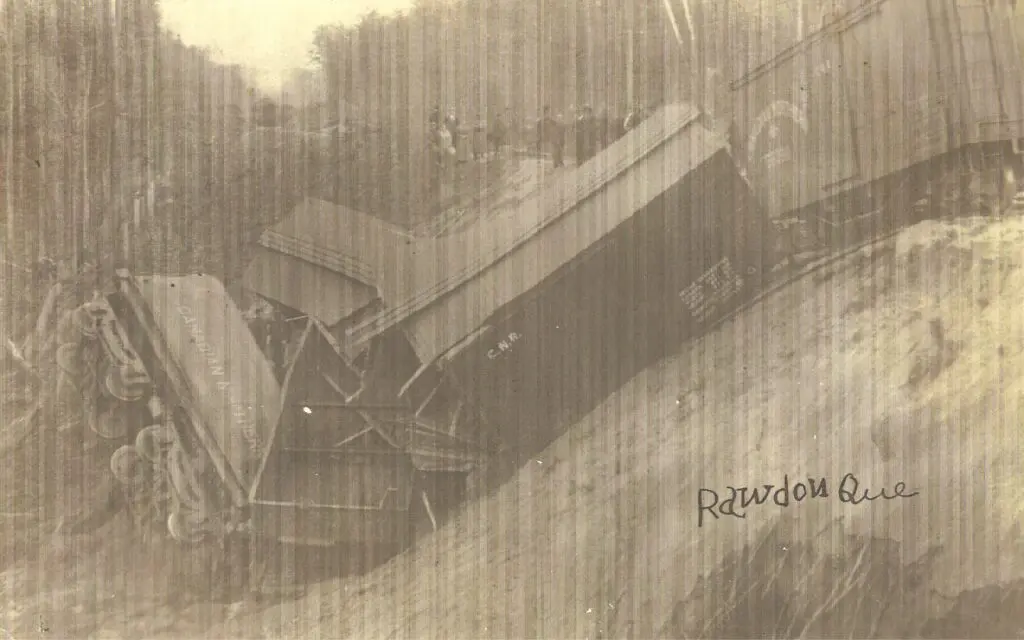
The End of the Line
On April 29, 1956, the national railways announced that rail service would be abolished for passengers.
The freight service, which is mainly used for the transport of wood, to be maintained for a certain time.
The following is a breakdown of car loadings for 1954 to 1956.
In 1954, Rawdon received 26 wagons and shipped 39.
In 1955, Rawdon received 16 cars and shipped 74.
In 1956, Rawdon received 23 wagons and shipped 62.
The tracks from Rawdon to Saint-Jacques were dismantled in 1964. Canadian National and its predecessors served Rawdon for 46 years. Today, the line has been gone longer than the time it existed.
On 23 July 1957 the agency was closed and replaced by a concierge. All the accounting, billing and telegraphing would be handled by Saint-Jacques. The agent, George Blais, had retired on 1 June and took over as caretaker of the property.
The caretaker was responsible for transmitting telegraph and billing information to St Jacques, as well as keeping the station clean and tidy. At this time, there were still many express parcels and freight sent by the express service.
On 29 April 1956, the regular passenger service ended.
The station house is now a private residence, and the turntable, water tower and goods shed have disappeared. The trestle has been dismantled and sold for scrap, and the giant concrete pillars, now over a century old, stand silently in the river as a testament to what once was.
The nearest station to Rawdon is in Mascouche. It has 14 stops and takes 62 minutes with double-decker commuter cars and dual-powered locomotives (electric and diesel – electric locomotives.
La fin de la voie ferrée
Le 29 avril 1956, les chemins de fer nationaux annoncent la suppression du service ferroviaire pour les passagers.
Le service de fret, qui sert principalement au transport du bois, sera maintenu pendant un certain temps.
Voici la répartition des chargements de wagons entre 1954 et 1956.
En 1954, Rawdon a reçu 26 wagons et en a expédié 39.
En 1955, Rawdon a reçu 16 wagons et en a expédié 74.
1956 : 23 wagons expédiés 62 wagons
1955 : 16 wagons expédiés 74 wagons
En 1956, Rawdon a reçu 23 wagons et en a expédié 62.
Les voies ferrées de Rawdon à Saint-Jacques ont été démantelées en 1964. Le Canadien National et ses prédécesseurs ont desservi Rawdon pendant 46 ans. Aujourd’hui, la ligne a disparu depuis plus longtemps que le temps où elle existait.
Le 23 juillet 1957 l’agence fut fermée et remplacée par un concierge. Toute la comptabilité, la facturation et le télégraphe seront gérés par Saint-Jacques. L’agent, George Blais, avait pris sa retraite le 1er juin et a pris la relève en tant que concierge de la propriété.
Le concierge était chargé de transmettre les télégraphes et les informations de facturation à Saint-Jacques, ainsi que de garder la station propre et ordonnée. À cette époque, il y avait encore beaucoup de colis express et de fret envoyés par le service express.
Le 29 avril 1956, le service régulier de transport de passagers a pris fin.
La maison de la gare est maintenant une résidence privée, la plaque tournante, le château d’eau et le hangar à marchandises ont disparu. Le tréteau a été démantelé et vendu à la ferraille, et les piliers géants en béton, maintenant vieux de plus d’un siècle, se dressent silencieusement dans la rivière comme un témoignage de ce qui était autrefois.
La gare la plus proche de Rawdon est à Mascouche. Elle compte 14 arrêts et prend 62 minutes avec des voitures de banlieue à deux étages et des locomotives à double motorisation (électrique et diesel – locomotives électriques.
On April 29, 1956, the national railways announced that rail service would be abolished for passengers. The freight service, which is mainly used for the transport of wood, will be maintained for a certain time.
Freight service, which is mainly used for the transport of wood, will be maintained for a certain time.
On April 29, 1956, the C.N.R. announced that rail service would be abolished for passengers.
In 1900 there was also an option to travel to l’Epiphanie by train then take a coach to Rawdon.
The following is a breakdown of car loadings for 1954 to 1956.
1956 received 23 rail cars shipped out 62 railcars
1955 received 16 railcars shipped out 74 rail cars
1954 received 26 railcars shipped out 39 railcars
The Mystery of the Dorchester
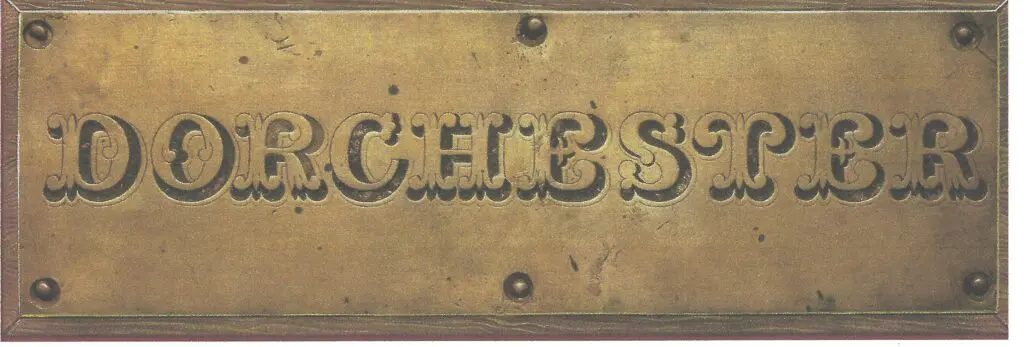
Though the exact route of Dorwin’s railway has never been fully traced, bridge abutments were said to be still visible. (Lavallée 1990). Since the annual report (1852- 53) indicating the line leased rolling stock and locomotives from the Saint Lawrence and Industry Village Railroad, the track structures must have been of similar construction and the gauge compatible. Might it be the Dorchester ever have travelled to Rawdon?
Bien que le tracé exact du chemin de fer de Dorwin n’ait jamais été entièrement retracé, des culées de pont seraient encore visibles. (Lavallée 1990). Puisque le rapport annuel (1852-1853) indique que la ligne louait le matériel roulant et les locomotives du Saint Lawrence and Industry Village Railroad, les structures de la voie ferrée devaient être de construction similaire et l’écartement des rails compatible. Se pourrait-il que la Dorchester se soit déjà rendue à Rawdon ?
An interesting side note is that the Saint Lawrence and Industry railroad eventually acquired Canada’s first locomotive, the Dorchester (nicknamed Kitten) which had initially run on the Champlain and St. Lawrence Railroad. The locomotive blew up one day and the pieces were dragged away for repair. Decades later a farmer found the nameplate Dorchester and turned it over to the clerks the same St Viateur in Joliette for safe keeping. This plaque is today at the Exporail in Delson. (Other stories told of the Dorchester have a tie, if rather tenuous, with the Rawdon area. In 1864 the Dorchester, now owned by the Lanoraie and Industry Railroad, exploded in a field when passing through St. Thomas de Joliette. The railroad wrote the engine off as a total loss and officially only the brass name plate was salvaged. This artifact is now in the Joliette Museum of Art.
Another reporter from the nearby village of Saint-Ambroise-de-Kildare swears that the parts have been reassembled and the locomotive rebuilt. After years of operating farm equipment, it now rests in his barn, but he refuses to show it……
Where is the Dorchester?
Il est intéressant de noter que le chemin de fer Saint Laurent et Village de L’Industrie a fini par acquérir la première locomotive du Canada, la Dorchester (surnommée Kitten), qui avait d’abord circulé sur le chemin de fer Champlain et Saint- Laurent. Un jour, la locomotive a explosé et les pièces ont été transportées pour être réparées. Des décennies plus tard, un fermier a trouvé la plaque commémorative Dorchester et l’a remise aux clercs de Saint- Viateur à Joliette pour qu’ils la gardent en sécurité.. (D’autres histoires racontées au sujet du Dorchester ont un lien, bien que plutôt ténu, avec la région de Rawdon. En 1864, le Dorchester, qui appartient maintenant au chemin de fer Lanoraie et Village de L’Industrie, a explosé dans un champ en passant par Saint-Thomas de Joliette. Le chemin de fer a déclaré que la locomotive était une perte totale et, officiellement, seule la plaque signalétique en laiton a été récupérée. Cet artefact se trouve maintenant au Musée d’art de Joliette.
Un autre rapporteur du village voisin de Saint-Ambroise-de-Kildare jure que les pièces ont été rassemblées et que la locomotive a été reconstruite. Après avoir servi pendant des années à faire fonctionner du matériel agricole, il repose maintenant dans sa grange, mais il refuse de la montrer……
Où se trouve la Dorchester?